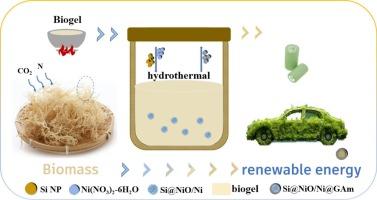封装Si@NiO/Ni量子点的藻类衍生凝胶碳框架构建锂离子电池阳极的高速电子传输通道
IF 8.9
2区 工程技术
Q1 ENERGY & FUELS
引用次数: 0
摘要
多层多孔复合材料具有多孔结构复杂、材料来源多样、环保无污染等优点,是一种极具发展前景的负极材料,为生物炭材料的发展提供了重要机遇,旨在持续提高锂离子电池(LIBs)的性能。本文介绍了一种新型的多孔生物质凝胶碳和纳米过渡金属氧化物与硅纳米颗粒的组合,作为锂离子电池的负极材料,即将Si@NiO/Ni纳米花包裹在天然氮掺杂的海藻凝胶碳(Gelidium amansii: GAM)中。生物质凝胶完美包裹Si@NiO/Ni纳米花,为多孔碳骨架提供充足的天然氮;硅纳米颗粒(NPs)有助于提高阳极材料的比容量;碳层减轻了电极体积膨胀,提高了循环稳定性;NiO扩展了锂离子的输运途径,进一步减小了硅纳米颗粒的体积效应;碳层的藻酸盐成分N与Ni一起工作以增加材料的电容量。碳层中的Ni共同作用以增加材料的导电性。藻类生物凝胶包裹的Si@NiO/Ni纳米花复合材料Si@NiO/Ni@GAM-5在1 a g−1的大电流下,经过1000次循环后的可逆容量为1245.12 mAh g−1。本文章由计算机程序翻译,如有差异,请以英文原文为准。

Algae-derived gel carbon framework encapsulating Si@NiO/Ni quantum dots to construct high-speed electron transport channels for lithium-ion battery anodes
Multilayered porous composites are promising anode materials with intricate porous structures, diverse material sources, and eco-friendly, non-polluting properties, which provide significant opportunities for the development of biochar materials aimed at sustainably improving the performance of lithium-ion batteries (LIBs). In this paper, a novel combination of porous biomass gel carbon and nano-transition metal oxides with silicon nanoparticles is introduced as an anode material for lithium-ion batteries, i.e., Si@NiO/Ni nanoflowers encapsulated in naturally nitrogen-doped algal gel carbon (Gelidium amansii: GAM). The biomass gel perfectly encapsulates the Si@NiO/Ni nanoflower and provides sufficient natural nitrogen for the porous carbon framework; the silicon nanoparticles (NPs) help to increase the specific capacity of the anode material; the carbon layer mitigates electrode volume expansion and enhances the cycling stability; while NiO expands the lithium-ion transport pathway and further reduces the volume effect of the silicon nanoparticles; and the alginate component of the carbon layer, N, works in conjunction with Ni to increase the material's electrical capacity. Ni in the carbon layer work together to increase the conductivity of the material. The Si@NiO/Ni nanoflower composite Si@NiO/Ni@GAM-5 encapsulated in algal biogel showed a reversible capacity of 1245.12 mAh g−1 after 1000 cycles at a high current of 1 A g−1.
求助全文
通过发布文献求助,成功后即可免费获取论文全文。
去求助
来源期刊

Journal of energy storage
Energy-Renewable Energy, Sustainability and the Environment
CiteScore
11.80
自引率
24.50%
发文量
2262
审稿时长
69 days
期刊介绍:
Journal of energy storage focusses on all aspects of energy storage, in particular systems integration, electric grid integration, modelling and analysis, novel energy storage technologies, sizing and management strategies, business models for operation of storage systems and energy storage developments worldwide.
 求助内容:
求助内容: 应助结果提醒方式:
应助结果提醒方式:


